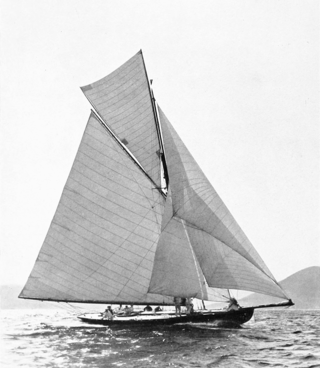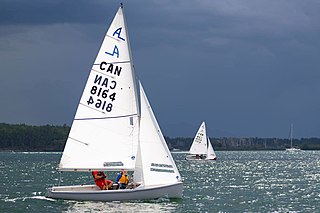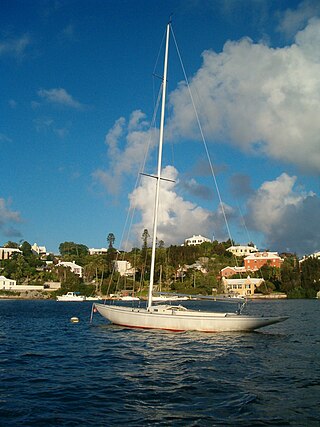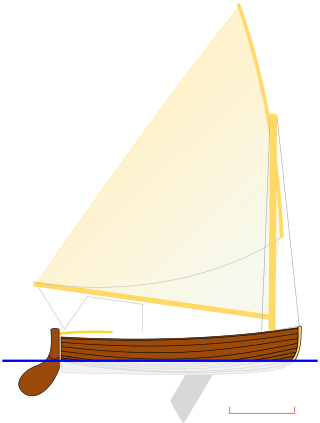
A sloop is a sailboat with a single mast typically having only one headsail in front of the mast and one mainsail aft of (behind) the mast. Such an arrangement is called a fore-and-aft rig, and can be rigged as a Bermuda rig with triangular sails fore and aft, or as a gaff-rig with triangular foresail(s) and a gaff rigged mainsail.

A sailing vessel's rig is its arrangement of masts, sails and rigging. Examples include a schooner rig, cutter rig, junk rig, etc. A rig may be broadly categorized as "fore-and-aft", "square", or a combination of both. Within the fore-and-aft category there is a variety of triangular and quadrilateral sail shapes. Spars or battens may be used to help shape a given kind of sail. Each rig may be described with a sail plan—formally, a drawing of a vessel, viewed from the side.

The Bermuda sloop is a historical type of fore-and-aft rigged single-masted sailing vessel developed on the islands of Bermuda in the 17th century. Such vessels originally had gaff rigs with quadrilateral sails, but evolved to use the Bermuda rig with triangular sails. Although the Bermuda sloop is often described as a development of the narrower-beamed Jamaica sloop, which dates from the 1670s, the high, raked masts and triangular sails of the Bermuda rig are rooted in a tradition of Bermudian boat design dating from the earliest decades of the 17th century. It is distinguished from other vessels with the triangular Bermuda rig, which may have multiple masts or may not have evolved in hull form from the traditional designs.

Dinghy sailing is the activity of sailing small boats by using five essential controls:
The Mirror is a type of popular sailing dinghy with more than 70,000 built.

Dinghy racing is a competitive sport using dinghies, which are small boats which may be rowboats, have an outboard motor, or be sailing dinghies. Dinghy racing has affected aspects of the modern sailing dinghy, including hull design, sail materials and sailplan, and techniques such as planing and trapezing.

The Albacore is a 4.57 m (15 ft) two-person planing dinghy, for competitive racing and lake and near-inshore day sailing. Hulls are made of either wood or fiberglass. The basic shape was developed in 1954 from an Uffa Fox design, the Swordfish. Recent boats retain the same classic dimensions, and use modern materials and modern control systems.

Gaff rig is a sailing rig in which the sail is four-cornered, fore-and-aft rigged, controlled at its peak and, usually, its entire head by a spar (pole) called the gaff. Because of the size and shape of the sail, a gaff rig will have running backstays rather than permanent backstays.

A Bermuda rig, Bermudian rig, or Marconi rig is a configuration of mast and rigging for a type of sailboat and is the typical configuration for most modern sailboats. This configuration was developed in Bermuda in the 1600s; the term Marconi, a reference to the inventor of the radio, Guglielmo Marconi, became associated with this configuration in the early 1900s because the wires that stabilize the mast of a Bermuda rig reminded observers of the wires on early radio masts.
A variety of sports are played in British Overseas Territory of Bermuda, from those brought by British and International relations, and sail racing). Some sports and events have greater historical and cultural significance whilst others are played for entertainment or competition.
A mast-aft rig is a sailboat sail-plan that uses a single mast set in the aft half of the hull. The mast supports fore-sails that may consist of a single jib, multiple staysails, or a crab claw sail. The mainsail is either small or completely absent. Mast-aft rigs are uncommon, but are found on a few custom, and production sailboats.

The International One Design is a class of sail boat developed in 1936 for yacht racing. It is a 33-foot open-cockpit day sailer used for day racing, rather than for overnight or ocean races. Popularised prior to the Second World War, the International One Design class is considered a classic one today.

His Majesty's Yacht Britannia was a gaff-rigged cutter built in 1893 for RYS Commodore Albert Edward, Prince of Wales. She served both himself and his son King George V with a long racing career.

The Twelve Foot Dinghy was designed by George Cockshott, an amateur boat designer from Southport, England in response to a 1912 design contest. It became the first one-design racing dinghy to achieve international recognition. The class was granted the 'International' status by the IYRU in 1919 and remained this status until 1964 when it was revoked by the same authority. The class was selected as the dinghy class for the Olympics in 1920 & 1928. In 1924 the French wanted to use an alternate French design.

The Royal Bermuda Yacht Club (RBYC) is a private yacht club that was established as the Bermuda Yacht Club on 1 November, 1844, after the sport of racing yachts had become established in Bermuda primarily as a pastime of idle officers of the Bermuda Garrison and the Royal Naval Dockyard, Bermuda. In 1845, Prince Albert consented to become Patron of the Club and in 1846 the club was permitted to add the adjective "Royal" to its name. The RBYC flies the blue ensign with the RBYC badge.

Charles Ernest Nicholson was a British yacht designer.

Spirit of Bermuda is a modern-built Bermuda sloop. She is a replica of a Royal Navy sloop-of-war, depicted in a well-known 1831 painting.
The following outline is provided as an overview of and topical guide to sailing:
The Tech Dinghy is an American sailing dinghy that was designed by George Owen, a professor at Massachusetts Institute of Technology (MIT), as a one-design racer and for sail training. It was first built in 1935.

The Royal Hamilton Amateur Dinghy Club (RHADC) is a private yacht club in the British Overseas Territory of Bermuda that was established as the Hamilton Amateur Dingey Association on, or before, 28 July 1882. It is the World's only Royal dinghy club.


















